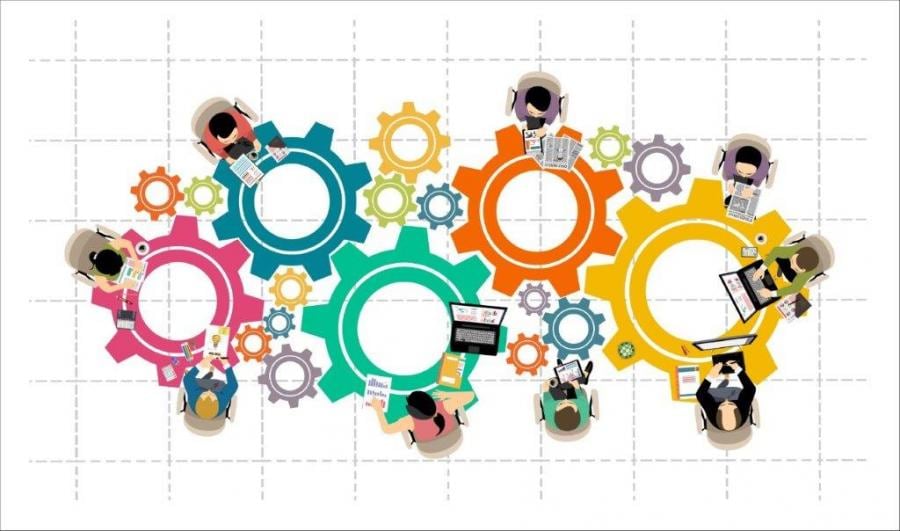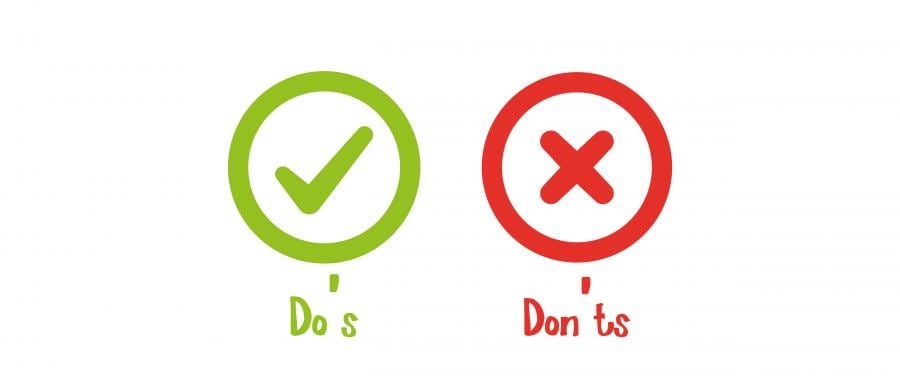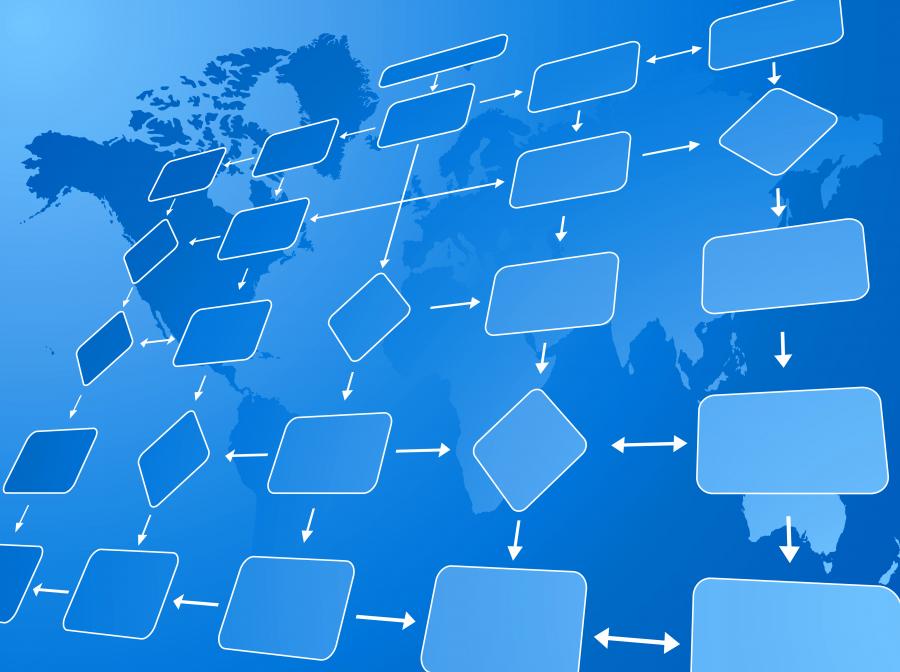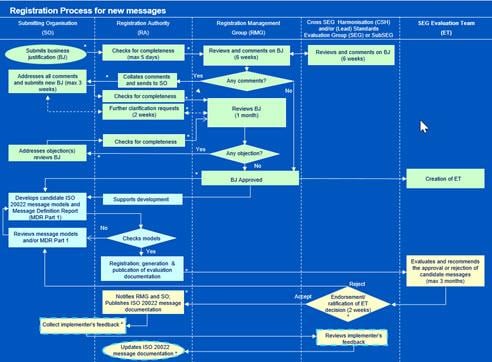Development of new ISO 20022 message definitions

The registration process for new message definitions includes several steps. Discover these steps and their requirements
The registration process for new message definitions includes several steps from the submission of a business justification, the evaluation by the group(s) of experts, the registration of the message definitions to the repository etc.
An organisation can request the registration of new ISO 20022 message definitions that does not exist in the current catalogue of messages.
ISO 20022 Message Definition Development Process: Step-by-Step
1. The submitting organization introduces a business justification
The submitting organization creates a business justification to give an overview of the scope, reason and estimated users / volumes / savings, etc. of the intended message set. The business justification also describes the commitment of the submitting organization to dedicate required resources to the development and support of the new message definitions. A business justification template is available from the ISO 20022 website.
The submitting organization sends the business justification to the Registration Authority (RA) at iso20022ra@iso20022.org where it is logged, checked for completeness and confirmed to the submitting organization. From this point on, the latest status of the submission is tracked on the ISO 20022 website with a copy of the latest version of the business justification. The RA distributes the business justification to the RMG members and the conveners, vice conveners and secretaries of the Standards Evaluation Groups (SEG) to be involved in the evaluation of the future messages as proposed by the submitting organization in the business justification. The RA also copies the Convener and Vice Convener of the Cross-SEG Harmonisation team (CSH) to investigate whether other SEGs should also be involved.
2. The RMG evaluates the business justification
The RMG evaluates the business justification and analyzes how the proposed development will improve communications and bring advantages to the industry. One major consideration of the RMG is to avoid utilizing resources of the ISO 20022 registration bodies in the analysis, registration, documentation, evaluation and publication of messages which may not be attractive enough to the targeted community. The RMG also wants to protect the industry against the proliferation of overlapping messages.
Commenting cycle
RMG members have six weeks to provide any comments or requests for clarification to be addressed by the submitting organization. During this cycle, the relevant SEG(s) as identified by the CSH - at least the SEG(s) suggested by the submitting organization in the business justification - will confirm that the proposed development falls into its scope and formulate its opinion on the business justification from a 'future users' perspective. The SEG also verifies that the submitting organization proposes to include the relevant industry bodies in the development. The SEG may challenge the information provided by the submitting organization and forward requests for clarification. When the scope of the business justification crosses the scope of several SEGs, all relevant SEGs will formulate their opinion.
If no comments have been received during the six-week commenting cycle (or only positive comments), the business justification is considered as approved. If comments have been received from the RMG or the SEGs during the commenting cycle, the RA sends them via e-mail to the submitting organization. The submitting organization is then given up to three weeks to update the business justification document and submit it to the RA. The updated business justification shall include:
Approval cycle(s)
As soon as the updated business justification is received, the RA checks it for completeness, saves a copy on the ISO 20022 website and submits it to the RMG members for approval. RMG members have one month to review the updated business justification and verify whether they have any objection against it. During the first week of this approval cycle, the RMG members may submit further clarification requests on the updated business justification to the submitting organization, which then have until the end of the second week of this one-month approval period to submit a new updated business justification addressing the requests for clarification.
If no objection is received on the updated business justification at the end of the one-month approval cycle, the business justification is considered as approved. If one or more objections have been received, the RA forwards them to the submitting organization and invites it to address the objection(s) with the objecting RMG member(s). If the objections can be addressed without need to further update the business justification, the business justification is considered as approved. If the objections can be addressed but requires to update the business justification or disposition of comments, then the submitting organization records the objections in the business justification, updates the text of the business justification or disposition of comments as required and submits the updated business justification to the RA which initiates a new one-month approval cycle.
If an objection cannot be addressed and the RMG leadership confirms that the objection is justified and reasonable within the scope of the ISO 20022 registration process, this is considered as a sign of sustained opposition and lack of consensus to approve the business justification. The RA records the reason for the sustained opposition in the business justification, logs it and updates the status of the business justification to 'rejected'.
The RA informs the RMG, the SEGs and the submitting organization of the approval/ rejection of the business justification. The approval of the business justification gives the green light to the submitting organization to start development. From this point on, the messages in development will be called 'candidate ISO 20022 messages'.
3. The SEG forms the Evaluation Team
Note: when the scope of the business justification crosses the business domain of several SEGs, the RMG will appoint a 'Lead SEG' to drive the future evaluation. If the business justification does not fall within the scope of any existing SEGs, the RMG will either initiate the creation of a new SEG or widen the scope of an existing SEG.
The approval of the business justification triggers the initiation by the SEG of the creation of a specific 'Evaluation Team' of experts in the field, which will validate the new set of messages once they are developed. The Evaluation Team will include members from the parent SEG. If necessary, additional experts will be selected by the SEG members to ensure strong representation of the future users of the messages.
When several SEGs are assigned the evaluation, the Evaluation Team is created by the Lead SEG and includes experts nominated by the other SEGs.
4. The submitting organization develops the candidate ISO 20022 message definitions
The submitting organization is expected to develop ISO 20022 compliant models and the other deliverables mentioned in the business justification within the timeframe indicated in the business justification. If, during the development, the submitting organization realizes that the committed deliverables will not be ready for submission to the RA at the date specified in the business justification, it will promptly inform the RA about the new submission date.
The RA is not resourced to undertake or participate in the development of the candidate ISO 20022 models, but provides the submitting organization with either a ready for use EMF-based modeling tool - the Editor - which helps creating the required deliverables and validating their ISO 20022 compliance, or the materials necessary for the submitting organization to set up itself a compliant EMF-based modelling environment, a clear description of the required deliverables and a checklist of rules to observe to ensure ISO 20022 compliance of the candidate models (ISO 20022 Submission Guidelines and Master Rules). It is important that the submitting organization always re-uses the existing ISO 20022 Repository items and/or bases its requests for new items on previously existing ones.
In the case of several concurrent submissions, the RA treats the requests on a first-come first-served basis, unless a different priority is decided by the RMG.
Once the development is completed and the RA has checked the compliance of the models as well as the quality of the requested Repository updates, the RA may enter the components of the "candidate ISO 20022 message definitions" in the Repository and mark them as "provisionally registered".
5. The SEG evaluates the candidate ISO 20022 message definitions
The RA generates the documentation for the evaluation of the candidate ISO 20022 message definitions by the SEG's Evaluation Team. The evaluation documentation is published as advanced draft information in each of the relevant business domain catalogue of messages (Payments, Securities, FX, Trade, Cards).The SEG documentation includes a description of the message definitions (Message Definition Report), possibly additional contextual documentation prepared by the submitting organization to introduce the transaction flow and/or illustrate the message usage, a copy of the XML or ASN.1 schemas generated by the RA from the models and examples of message instances if prepared by the submitting organization.
A representative of the submitting organization is always invited to participate in the Evaluation Team. She/he is expected to introduce the new message set to the Evaluation Team and allow the Evaluation Team members to gain additional clarification regarding the content, business context and intent of the submission during the evaluation process. When several organizations have made a joint submission, all of them are invited to participate in the Evaluation Team.
As a preliminary step, the Evaluation Team verifies that the candidate message definitions are within the scope expressed in the business justification that was approved by the RMG. If not, the SEG will ask the submitting organization to justify the changed scope and, if agreed, to update the business justification accordingly. In some instances, the SEG may request the submitting organization to re-introduce the updated business justification to the RMG for approval.
The main task of the Evaluation Team is to evaluate the message definitions from a business perspective, that is, the developed message definitions actually address the users' needs and can be used by the user community represented by each Evaluation Team member. This includes the validation of the transaction flow, the message scopes, the message descriptions, including all (new or re-used) components, definitions, etc., as included in the SEG documentation.
When the candidate ISO 20022 message definitions support a specific part of a whole transaction life cycle, the Evaluation Team also takes into account the information requirements of actors that come into play earlier or later in the end-to-end transaction lifecycle.
The Evaluation Team strives to reach a 'consensus recommendation' regarding either the approval or rejection of the candidate message definitions. This is done as quickly as possible and within a maximum of three calendar months, unless otherwise agreed with the RMG.
The Evaluation Team submits the Team's consensus recommendation to its parent SEG for endorsement. The SEG is expected to endorse the recommendation of its Evaluation Team within two weeks and communicate its decision to the RA. The RA then officially notifies the submitting organization and the RMG of the newly approved "ISO 20022 message definitions".
6. The RA publishes the ISO 20022 message definitions
It is only after the approval by the SEG that the candidate ISO 20022 message definitions can be called 'ISO 20022 message definitions' (or ISO 20022 compliant message definitions).
The RA publishes the ISO 20022 message definitions on the ISO 20022 website. This includes:
Publishing the Message Definition Report, XML or ASN.1 schemas and examples of message instances in the Catalogue of messages.
Registering the new message definitions and all related message items in the Business Process Catalogue.
Officially registering new or updated Data Dictionary items (items that would have been 'provisionally registered' are switched to 'registered' status).
Making a new version of the ISO 20022 Repository accessible through both the e-Repository function (that allows to download an EMF-based repository containing all approved message definitions and a copy of the Data Dictionary) and through the Repository Search function.
During the entire registration process, the RA keeps the status of the submissions updated.
7. Testing and implementation
Until the newly published message definitions have been tested or implemented, one cannot fully guarantee that:
The submitting organization is also invited to review the published documentation and organize/encourage testing and implementation of the message definitions.
The submitting organization, testers or first implementers are invited to communicate to the RA any remarks they have on the published documentation. The remarks may include proposals for changes to clarify the documentation, align it with what was approved by the SEG, eliminate ambiguity or correct errors that prevent implementation of the message definitions. They may include proposals to make the message definitions easier to implement or process, but may normally not include new business requirements, unless (1) they are in the scope of the business justification and (2) the SEG, the RA and submitting organization jointly agree that the proposed changes can and must be implemented as soon as possible to ensure adoption of the message definitions.
If a correction of the message definitions and/or documentation is approved, the new publication is clearly announced on the ISO 20022 website and an 'errata' with the list of the changes is published by the RA for the convenience of implementers who would have started using the initial version of the messages/documentation. If the message schemas have been 'patched' to correct a mistake (the schemas did not reflect what the SEG had approved) or an error (the schema was invalid), the corrected schemas bear a new generation timestamp but keep the same version number. If any other change is made to a schema (improvement, new requirement), the message version number is increased.

Development of new ISO 20022 message definitions request
Any request for the development of new ISO 20022 Message Definitions must be submitted to the ISO 20022 RA, using the form below.
Please download and fill in the Business Justification as you will have to attach it to the submission form.

Supporting documents for the development of new Message Definitions

ISO 20022 registration procedures
Should you want to know more about the ISO 20022 registration process, you can download the document hereafter which provides detailed information about the process.

New Message Definition Development Process Overview
Flow chart of the process
